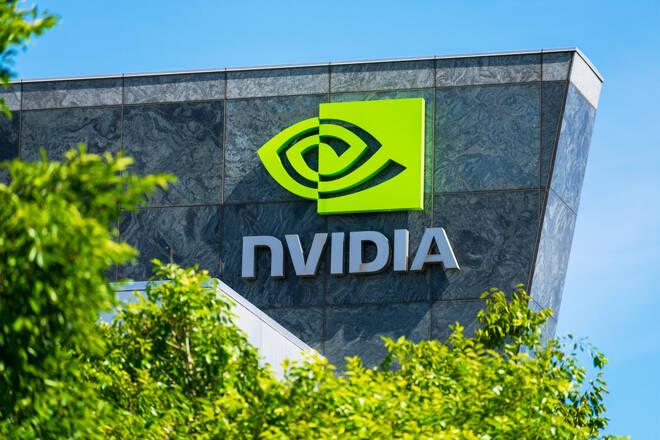Advertisement
Advertisement
QQQ: The Downside Risks on the Nasdaq Seem Exaggerated
By:
This is a completely different market regime than seen in 2020 and 2021.
The performance of the Nasdaq now encompasses a higher degree of volatility as seen by the 5.5 to 9% corrections in the Invesco QQQ Trust (QQQ) which has now become the new normal in a macroeconomic environment where hawkish Fed hiking interest rates is seen as being unfavorable to high-valued and unprofitable tech stocks.
Source: Initial chart from Trading View
For investors, QQQ tracks the Nasdaq-100 Index which features Apple (APPL), Alphabet A (GOOGL), Alphabet C (GOOG), Microsoft (MSFT), NVIDIA (NVDA), Meta labs (FB), Amazon (AMZN), Tesla (TSLA), Adobe (ADBE) and PayPal (PYPL). These are the main holdings out of a total of 102.
Assessing the risks
There are certainly risks in 2022 in the context of being invested in tech equities, but, I would like to bring to the attention of investors that despite all the volatility, QQQ has gained 6%, and this shows that the market’s repositioning (amid the rotation from growth to value names) does not seem commensurate with the forthcoming pace at which interest rates will increase.
Exploring further, trades are no longer crowded as in 2021 as people look for income or other asset classes to diversify. However, this diversification away from tech seems not to have hit QQQ’s main holdings which constitute 52.73% of the portfolio. As per my observation, this has been the case from April through December this year when most of the market gains were just from AAPL, MSFT, NVDA, TSLA, and GOOGL.
Source: Ycharts.com
Given the fact that the rotation has lacked in breadth, I see the corrections in tech as a rather muted market reaction, and this also prompts me to discard fears that tech stocks will suffer in the same way as during the bursting of the Internet bubble back in 1999-2000. At that time, in the first phase of the bear market, the large-caps names were doing fine but a large percentage of Nasdaq’s other components crashed by more than 50%. Ultimately, all the components crashed.
However, that was a completely different Nasdaq with the top stocks of the time being Cisco (CSCO) followed by Microsoft then Intel (INTC), or from the networking, software and semiconductor sectors respectively. Today, it is more about social media, online advertisement, internet marketplaces, electric cars, the cloud, smartphones, and virtual reality. In short, tech is now fully integrated into all spheres of economic and social life compared to twenty-two years ago.
Considering the inflation factor
Moderating slightly, QQQ’s other holdings seem to be impacted as investors become more selective, putting more emphasis on quality (free-cash-flow, balance-sheet, economic moat, etc) and valuations. Still, here also, rising inflation, currently at above 7% compared to 3.75% in 1999-2000 could prove to be more difficult for value stocks like banks as their customers suffer from rising prices and are faced with the rising cost of doing business. For this matter, as shown in the chart below, Bank of America (BAC) and Berkshire (BRK.B) saw a more pronounced dip in their total return level in August 2008 than Apple or Microsoft when inflation was above 5%.
Source: Ycharts.com
Industrials are also likely to suffer from soaring raw material and labor costs. As for tech, they should better withstand high inflation with their ability to make use of software, AI, and automation tools more rapidly than companies from other sectors of the economy. These tools enable them to reduce operating costs and better circumvent wage inflation. Examples are FinTechs like PayPal’s (one of QQQ’s current underperformers) ability to reduce money transfer fees for customers compared to traditional banks and companies making use of cloud-based collaboration instead of having to invest in costly infrastructure.
Tech should continue to outperform as digital transformation enablers
Furthermore, with relatively less dependency on physical interactions caused by variant-related uncertainty, tech stocks are less likely to see a reduction in profitability. Here, some will note that Apple’s revenue share from its App Store ecosystem is increasing more rapidly than for devices and Tesla is considered as an internet-of-cars company.
Historically, as shown in the chart below, big tech’s gross profit margins have either increased or remained constant during the last five years, which include 2021, a year characterized by rapidly rising inflation.
Source: Ycharts.com
Thus, inflationary pressures grappling the economy as from 2022 is likely to put valuations on the backstage, with tech, especially the more profitable ones, likely to continue seeing positive returns. This said tech remains highly dependent on semiconductors, a sector that needs to be watched closely for some short term pain when some of the big names report earnings on the last week of January. Finally, looking at the performance of the Nasdaq in 2020 and 2021 when it gained 43.64% and 21.39% respectively, even a 10-12% gain in 2022 would put it in positive territory.
Disclosure: I am long Apple. This is an investment thesis and is intended for informational purposes. Investors are kindly requested to do additional research before investing.
About the Author
Chetan Wooduncontributor
Chetan Woodun has a Masters in Information Management and a Post Graduate Diploma in Business Management and Industrial Administration. He is certificated in Cloud, AI, Blockchain, IoT, Equity Finance, Datacenter and Project Leadership.
Advertisement
